Entering Shows, A Road Map
Posted by Leni Levenson Wiener on Jun 21st 2017
This is the second part in an ongoing series on entering shows from Leni Levenson Wiener, the author of Pictorial Art Quilt Guidebook. You can read the first part here.
Now that you have decided to start entering shows, here are some helpful hints.
There are several different kinds of shows. In this post I will address calls for entry (when a juror chooses from submitted entries), as this is the most common type of quilt or art quilt exhibition you are likely to encounter. Most often the juror chooses the works in a “blind” jury process, which means the artists’ names are never visible, thus avoiding favoritism or influence.
When entering a show, the first thing to ask yourself is whether or not this is a good fit for your artistic style and whether inclusion in this exhibition will help your long-term career goals. If not, pass. There are plenty of calls for entry out there; find the ones that fit you best.
The call for entry is summarized in a prospectus.
The theme:
Read the theme carefully and decide if it fits your work. It is always best to produce a body of work and pull from it when entering shows, but sometimes a theme is so compelling you want to create something specifically for the show. When you do, the piece you make should fit seamlessly into your portfolio. Your work should always speak in your voice; don’t deviate just to try and get into a particular show.
Resist the urge to rename an existing piece to try and retrofit it. Your entry should speak for itself; the title of it won’t sway a decision.
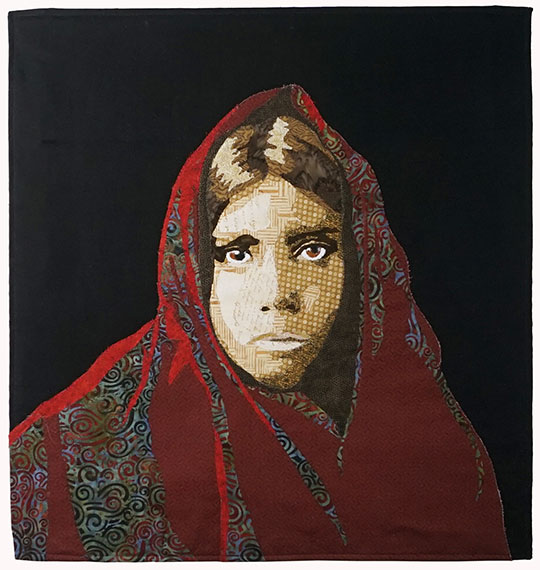
This was made for a call of entry, but it fit my body of work so well that I decided not to enter it, but to make it part of a new series.
Size matters:
Venues love the cohesive and appealing look of similarly sized works hanging together and usually set a minimum and maximum size for the show. Pay attention! I have often heard artists say, “Well, it is only off by an inch, what difference could that make?” It could make the difference between acceptance and rejection. No matter how fantastic your piece is, the show parameters will not be altered to accommodate it. Sometimes the decision on size is aesthetic, sometimes it has to do with the size of the walls or even the shipping containers if the show will travel. Submitting a piece that is even only a tiny bit off the minimum or maximum is guaranteed to bring disappointment.
The timeline:
Many shows travel to more than one venue, so make sure you understand how long your piece will be away from home. It is also critically important that you do not enter shows that overlap. If you get into both (lucky you!), it is very unprofessional to turn one down because the piece won’t be back in time.
The photo:
The photo is all the juror sees of your work, so ensure that it represents the work in the best possible light—literally. It should be evenly lit, in nice sharp focus, with the edges showing and looking flat and square in the frame. Your quilt should be shot on a white background (if the edges are white, you can use a gray background) with no feet, arms, garage doors, kitchen cabinets, or floors and NOTHING else (not even your adorable cat or that precocious puppy) in the frame. Shoot the details as separate photos; if you crop them out of the whole photo, they will be out of focus when blown up. And please pay attention to the size and format requested in the prospectus, or it may not be visible at all to the juror. There is a lot of good information on the internet about how to photograph your artwork, but if you really don’t think you can do it yourself, consider having it done professionally.
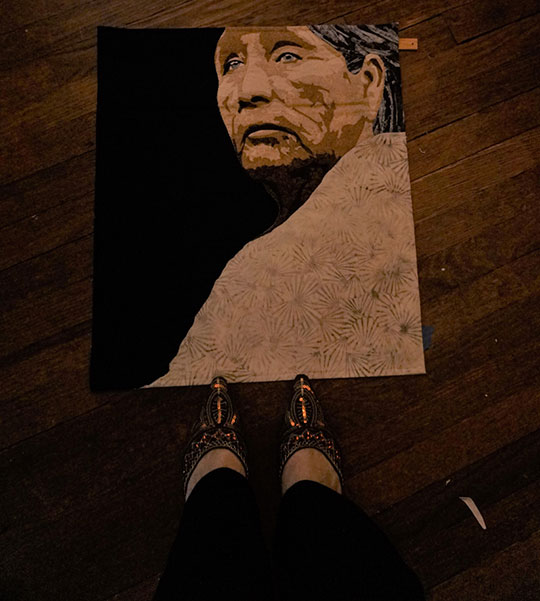
There is a lot wrong with this photo, but aren't my shoes cute?
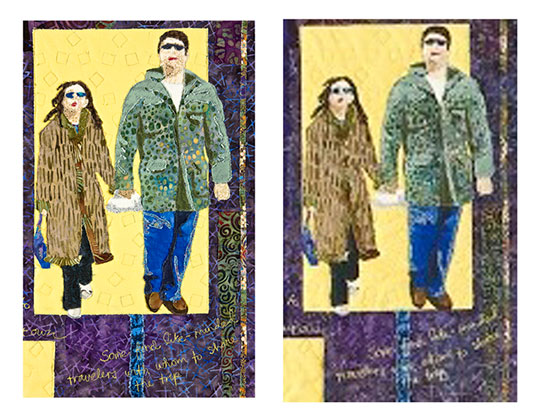
Shoot the detail as a separate shot, don't crop it out of the whole image.
Make it easy:
Whenever I finish a new piece, I photograph it and save both a high-resolution and low resolution copy in a folder on my computer. I name it with the title, the size, and the date for easy reference. I keep a database of all pieces, including which shows they were entered into, which accepted and rejected, and any other important notes. I write an Artist Statement and short bio (which I will discuss in another post) that I update periodically and save for quick and easy access. When I enter a show, everything is ready and it only takes a minute. Entering shows from your completed body of work is much less stressful than making pieces for every call and every deadline.
Check out the show:
If the show you are entering has a history, look at past exhibitions. I was once rejected from a show only to see it a few months later and realize that my representational piece was not a fit for the highly conceptual exhibition. If only I had looked at a prior year (or read the prospectus more carefully), I would have known my entry would be rejected.
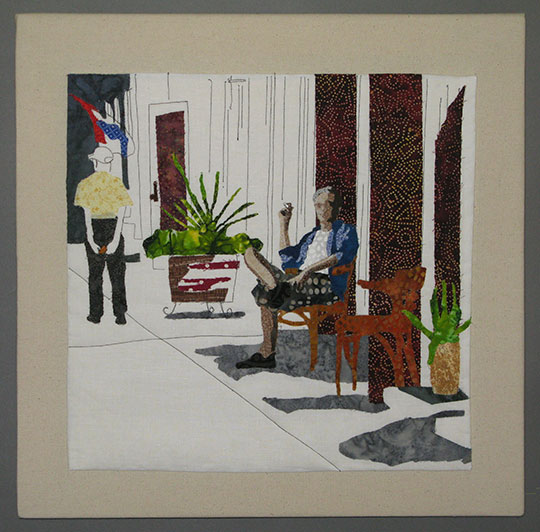
I loved this pieced, but the show I entered it into wasn't the right fit.
The deadline:
Usually about 50% of the entries come in the last 24 hours of the call period, and a large majority of those in the last hour. If you run into a technical issue only a few minutes before the deadline, there will be no time to get help. I even know an artist who entered a show in the last five minutes, only to find she hadn’t paid attention to the timezone and missed the deadline by a few hours. I always subtract at least one week from the real deadline in my own notes so I have some wiggle room.
Final checklist:
Before you hit send, re-read the prospectus. Is your work right for this show; are the pieces you are entering consistent in style and technique; did you check the timeline against other commitments; is the photo a good representation of your piece, and is it the right format and size; did you include the entry fee?
The acceptance is great, but what about that rejection letter?
Yes, the rejection is painful but chin up; even the best-known artists get rejections and feel just as badly as you do. Indulge in self pity for a bit and then learn from the experience.
Remember the juror (or jurors) chose the works from those submitted. The juror fully understands the concept and is responsible for the final vision of the show, not just picking what they like. A lot of consideration goes into how all the chosen works fit together, like elements of one large artwork.
Perhaps there were too many pieces submitted with similar techniques or color palette or that interpreted the theme in a similar way. Remember in the last post I talked about the importance of a cohesive and consistent body of work? Sometimes the juror chooses a piece, but it does not fit anywhere in the assortment (yes, the hanging order is often decided at the acceptance point) so they take the other entry by the same artist instead because it has the same voice and provides a better flow from one piece to another.
No matter how disappointed you are, PLEASE resist the urge to email the juror! They don’t know your name or what piece was yours (remember the jury process is blind), and they aren’t going to go back to their notes to figure it out. It not only puts the juror in a very uncomfortable position, they also don’t have the time to give feedback to every rejected artist. So be professional, accept the decision, and if in doubt about the quality of your work, arrange a professional critique.
Every artist will tell you a story about a piece that was rejected from one show and went on to be part of (or even win an award in) another. Stay the course and try again.
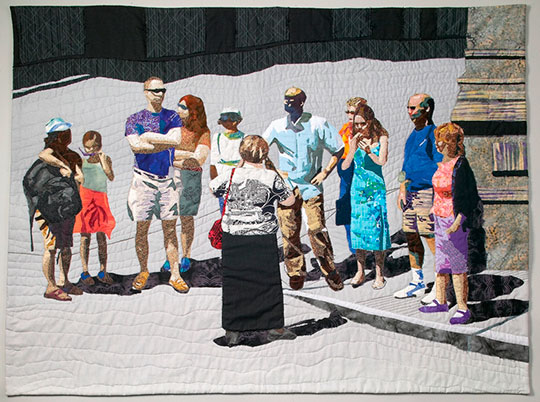
Rejected from one show, exhibited many times in others.
Good luck!







